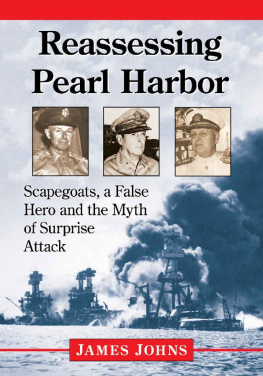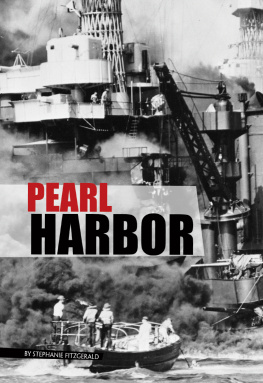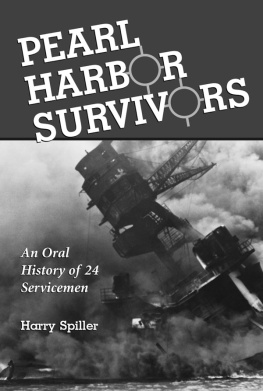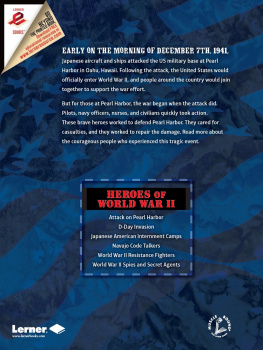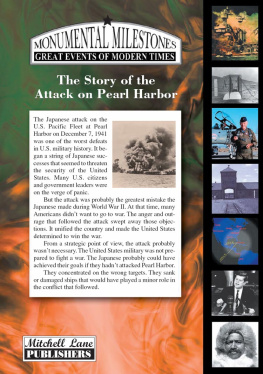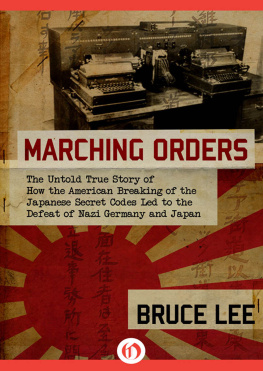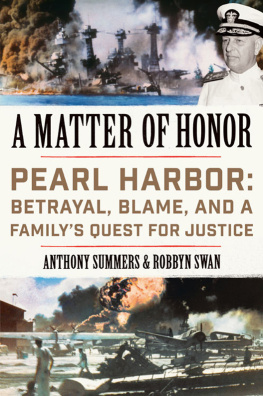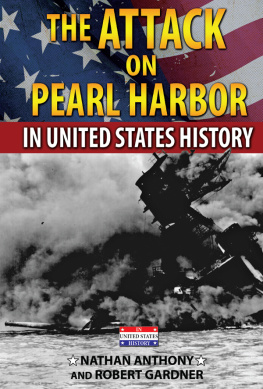REASSESSING PEARL HARBOR
Scapegoats, a False Hero and the Myth of Surprise Attack
James Johns

McFarland & Company, Inc., Publishers
Jefferson, North Carolina
All photographs are from the authors collection unless noted otherwise.
LIBRARY OF CONGRESS CATALOGUING DATA ARE AVAILABLE
BRITISH LIBRARY CATALOGUING DATA ARE AVAILABLE
e-ISBN: 978-1-4766-2833-2
2017 James Johns. All rights reserved
No part of this book may be reproduced or transmitted in any form or by any means, electronic or mechanical, including photocopying or recording, or by any information storage and retrieval system, without permission in writing from the publisher.
Front cover: insets, left to right Walter Short (U.S. Department of the Interior), General Douglas Macarthur, 1945 (Library of Congress), Admiral Husband E. Kimmel, Commander in Chief of the U.S. Pacific Fleet (Office for Emergency Management, Office of War Information), background burning and damaged ships at Pearl Harbor, December 7, 1941, left to right: USS Arizona, USS Tennessee and USS West Virginia (Department of the Navy, Naval Photographic Center)
McFarland & Company, Inc., Publishers
Box 611, Jefferson, North Carolina 28640
www.mcfarlandpub.com
For
Ensign E. Tom Child
Torpedo Officer, USS Cassin (DD 372)
Pearl Harbor
7 December 1941
Ensign Barron W. Chandler
Executive Officer, PT 34, Motor Torpedo Boat Squadron 3
Manila Bay
8 December 1941
and
First Lieutenant Lars C. Jensen
45th Infantry, Philippine Scouts
Ft. McKinley, Luzon
8 December 1941
Table of Contents
Preface
November 25, 1941, was the thirteenth day before the attack on Pearl Harbor. Several things happened on that day. The Kido Butai departed the Kurile Islands. A secret White House conference was convened to determine how the Japanese could be maneuvered into attacking first, hopefully without Americans suffering too much damage. And on that day, the Vacant Sea Order was issued, which cleared the way for the Japanese attack force.
On November 26, knowing that the Japanese were on their way, FDR ordered that the modus vivendi, which would have provided a diplomatic cooling-off period, be replaced with the Ten Point Note which, in essence, demanded war. And on November 27, 1941, the eleventh day before the Pearl Harbor attack, the weak and ambiguous war warnings were sent to Pacific commands which, compared to what Washington actually knew, didnt warn of a thing. Even by then, the American public had no conception of how drastically their lives would change in just ten more days.
As a young boy, I had no idea how these events would shape history, but I knew family members and close family friends who would become veterans of Pearl Harbor, Bataan, and Bulkeleys PT boats, some of whom did not return. After serving a career in the military, and with fifty years of aviation experience, my interest in the Pearl Harbor attack and the fall of the Philippines came naturally.
Throughout my career, I have aligned myself with numerous organizations whose exploits have held my interest. Those organizations include the Fourth Armored Division Association, the Philippine Scouts Heritage Society, the Army Aviation Association of America, the Eighth Air Force Historical Society of Minnesota, and the Minnesota Aviation Hall of Fame. My ten years of research for this book also includes countless interviews with World War II veterans, many of whom were Pearl Harbor and Bataan survivors; documentary research at the National Archives in Washington, D.C.; correspondence with the Japanese Fighter Pilots Association in Tokyo; and base heritage records in Hawaii.
One cannot count the number of books that have been written about Pearl Harbor, as well as the fall of the Philippines in 1942. Many credible historians have specialized in various aspects of these events, but because the attacks on Pearl Harbor, the Philippines, Malaya, and the Indies were all timed to the minute by the Japanese, it is important to report all of these events simultaneously as part of Japans major operation. What went wrong for them actually provided the Allies with a warning and time to prepare, an opportunity that was ignored by General MacArthur.
Given that the attacks on Pearl Harbor and the Philippines were so intertwined, through similarities, contradictions, and devastation, it is very disconcerting to consider the disparity in how the Hawaiian and Philippine commanders were treated after the fact.
Millions of Americans sacrificed much during the war. Two of those Americans, Admiral Husband Kimmel and General Walter Short, who had dedicated their lives in service to their country, were also sacrificed to meet the political motivations of the day, while General Douglas MacArthur was actually rewarded. I want readers to know that the real story is not always as it seems. While some will attempt to conceal the facts to suit the purposes of a few, those who open their minds to the underlying themes will discover a story that uncovers the power and politics at playthe power and politics that really opened the door to war.
Although I originally had no intentions of publishing this manuscript, I have been fascinated with Pearl Harbor since the age of seven. After transcribing my work, Marilyn Curski, a World War II enthusiast, convinced me that perhaps a reminder was due Americans of the actual events surrounding the Pearl Harbor disaster. Over the next several years, she helped me with countless additions, revisions, and editing, for which I am very grateful.
And to my wife, Dorothea, I owe my deepest gratitude for her patience and all the sacrifices she made on my behalf throughout this entire project. Without her support and understanding, it may have otherwise wound up buried in a closet.
Principal Characters
UNITED STATES
President Franklin D. Roosevelt
Secretary of State Cordell Hull
Secretary of War Henry Stimson
Secretary of the Navy Frank Knox
Rear Admiral Walter Anderson Commander Battleships, Pacific Fleet
Colonel Rufus Bratton Chief, Far Eastern Section, Military Intelligence Division
Brigadier General Lewis Brereton Air Force Commander, Philippines
General Leonard Gerow Assistant Chief of Staff, War Plans Division
Joseph Grew United States Ambassador to Japan
Admiral Thomas Hart Commander-in-Chief, Asiatic Fleet
Harry Hopkins Advisor to President Franklin Roosevelt
Admiral Husband Kimmel Commander-in-Chief, Pacific Fleet
Lieutenant Commander Alvin Kramer Section Chief, Naval Intelligence
General Douglas MacArthur Commanding General, Philippine Department
Lieutenant Commander Arthur McCollum Head of Far Eastern Section, Naval Intelligence
General George C. Marshall Chief of Staff, U.S. Army
Brigadier General Sherman Miles Assistant Chief of Staff, Military Intelligence Division
Rear Admiral Leigh Noyes Director, Naval Communications
Lieutenant William Outerbridge Captain, USS Ward
Captain Laurence Safford Head, Communications Security Division, Naval
Lieutenant General Walter Short Commanding General, Hawaiian Department
Admiral Harold Stark Chief of Naval Operations
Brigadier General Richard Sutherland Chief of Staff to General MacArthur
Rear Admiral Richmond Turner Director of War Plans
Rear Admiral Theodore Wilkinson Director, Naval Intelligence

